Pictures of Southeast Asia From a Celebrity Cruise

On This Page
- Hong Kong Skyline at Night
- Hong Kong Neighborhoods
- Hong Kong Highlights
- Halong Bay, Vietnam
- Halong Bay Overnight Junk Cruise
- A Floating Village in Halong Bay
- Hoi An Food and Fun
- A Day in Saigon -- Err, Ho Chi Minh City
- Uncle Ho's City
- And It's Good Pho You
- Cruise and Tell
- Over-the-Top Bangkok, Thailand
- The Reclining Buddha
- Sensational Singapore
- The Singapore Sky Show
- Singapore Slinging
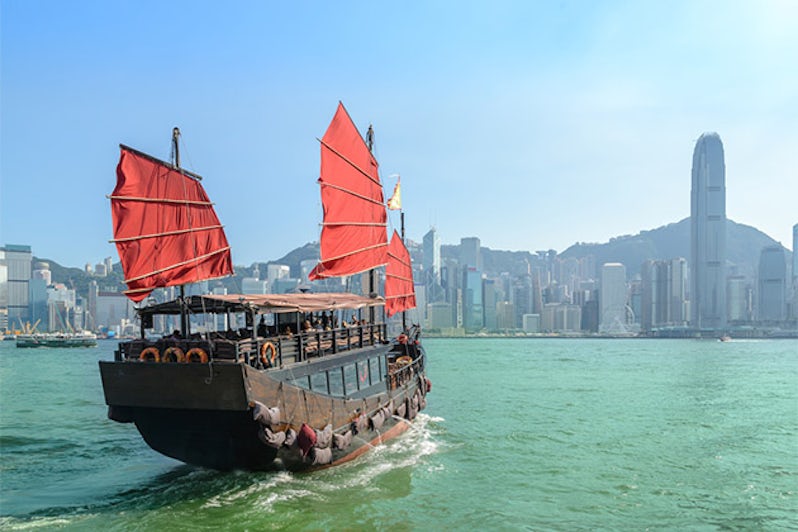
Southeast Asia has increasingly captivated cruisers looking for new adventures where food, architecture and cultural contrasts are as vivid as they are exotic. They're drawn to this far side of the world with its wonderland of rice paddies, ancient temples, bustling outdoor markets and friendly people.
Almost every cruise line has two or more ships active in Southeast Asia, with most cruises originating in Australia, Singapore or Hong Kong. Itineraries include ports of call in Vietnam, Thailand, Malaysia and Indonesia. Because many of the major destinations are a distance from ports, most ships dock for two days, allowing overnight visits to Hanoi and Bangkok, for example. Ships departing from Hong Kong or Singapore often board one day and sail the next to give passengers more time to explore these fascinating cities.
Click through this slideshow to see the highlights of a typical Southeast Asia itinerary -- a 14-night cruise on the Celebrity Millennium that sailed south from Hong Kong and ended in Singapore.
Hong Kong Skyline at Night

The colorful Hong Kong skyline glowed outside our cabin balcony while Millennium docked at the sprawling Kai Tak cruise terminal at the start of our cruise. Plan to arrive a few days early to explore this cosmopolitan city’s distinct, skyscraper-covered neighborhoods, home to more than seven million wealthy and working-class "Kongers." In the Central District -- filled with international financial service companies, familiar chain stores and high-end boutiques -- wealthy visitors from mainland China form long lines outside stores to purchase pricy designer clothing, bags and watches (there seem to be as many Gucci and Armani stores as 7-Elevens).
Tip: The giant Kai Tak cruise terminal opened in mid-2013 and built on the site of the former airport, is state of the art in almost every way except it’s several miles from city hubs. Allow time to take a taxi there, and expect a surcharge for crossing the bay. Ships docked overnight at Kai Tak often offer shuttles to Kowloon shopping centers with access to the city’s subway system.
Hong Kong Neighborhoods
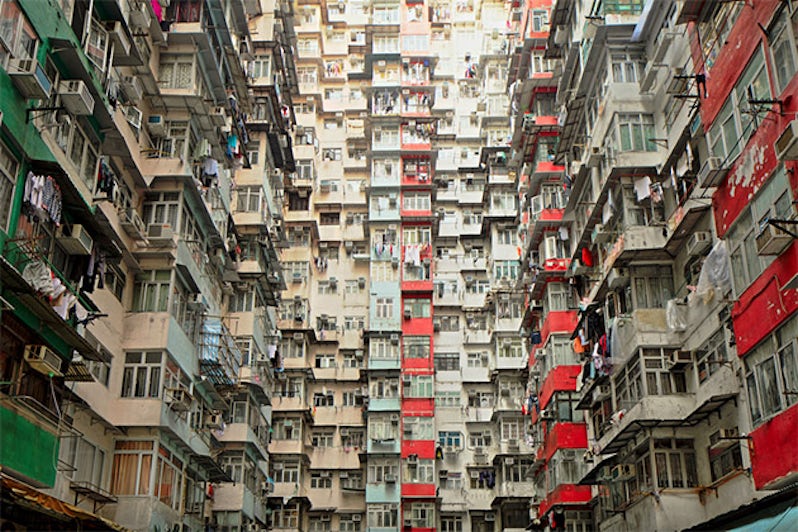
Just a few blocks away from the uber-affluent Central District is a very different Hong Kong. The Western District, or Sheung Wan, looks like the set of an old Chinese movie mystery with extras still hanging around. It is the city’s oldest area, where colorful shops are jammed with boxes piled high with dried whole fish, shrimp and countless shark fins. This is also where scores of Chinese herbal medicine shops sell traditional imported remedies from the Chinese mainland. Nearby, street butchers, fishmongers and vegetable stalls add to this adventure for all your senses, especially your eyes and nose.
Tip: Travel between the central and western districts on one of the historic, double-decker Hong Kong trams or "ding-dings," as the locals call them, referring to their clanging bells. Fares, payable in Hong Kong dollars only, are inexpensive.
Hong Kong Highlights
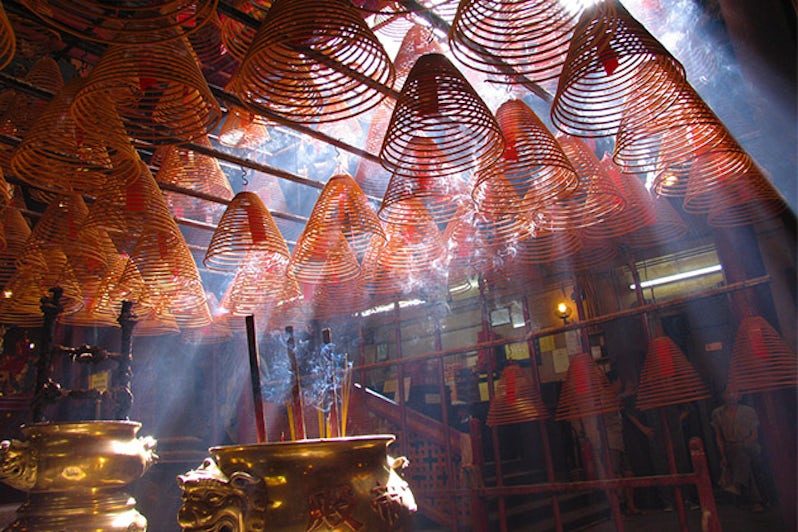
A custom Big Foot Walking Tour of central Hong Kong introduced us to the city’s many flavors. We visited incense-clouded Man Mo Temple (pictured here), one of the first traditional temples built during Hong Kong’s colonial period. Nearby Hollywood Road is lined with high-end curio and antiques shops, while its cross streets and alleys house inexpensive souvenir stalls. Follow Hollywood to the world’s longest covered escalator for a lift to the hip cafe-filled SoHo and Lan Kwai Fong areas. Other highlights included a Star Ferry ride across Victoria Harbor to crowded Kowloon and the ride on the historic tram to enjoy city vistas from the top of Victoria Peak.
Tip: There are two lines -- both long -- for the Victoria Peak Tram ride: one for tickets, the other to board the tram. Cut your line time in half with a Hop On, Hop Off bus tour that lets you go directly to the boarding line, avoiding the ticket line. Best views, up and down, are on the boarding side of the tram.
Halong Bay, Vietnam
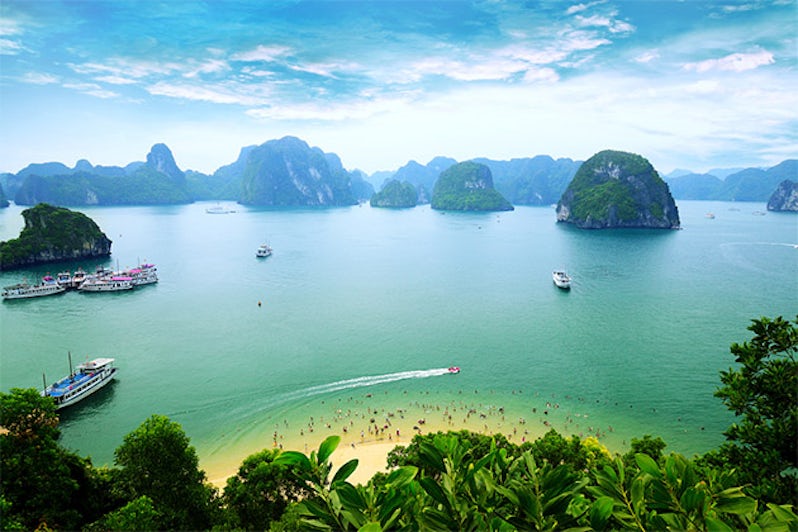
Millennium, like most large cruise ships, anchors in Halong Bay. While it’s billed as the Hanoi stop, the city is more than 100 miles away -- and can’t compete with this picturesque bay dotted by nearly 2,000 mystical islands, a UNESCO World Heritage Site. Wind- and sea-carved limestone islands in fantastical shapes and sizes appear and disappear into mists that frequently shroud the bay. Most cruise ships travel though some sections of the bay as they arrive and depart, but there’s no substitute for taking a junk tour of the bay. The junk cruises enable passengers to view the islands up close, explore dramatic caves and visit an active, floating fishing village.
Tip: Fog on the bay tends to disperse later in the day, so consider an afternoon or overnight junk cruise. If the fog or haze lingers, don’t despair; it’s a magical backdrop to these fancifully shaped islands.
Halong Bay Overnight Junk Cruise
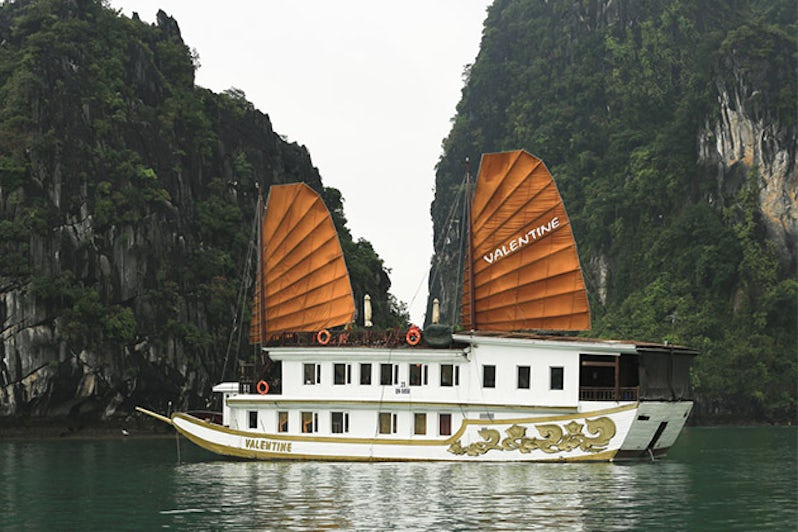
Few experiences match a deluxe, overnight junk cruise on Halong Bay. Because the Celebrity Millennium anchored in the bay for two days, we booked a private excursion not offered by the ship to spend the night aboard a junk, a beautifully crafted three-level boat with 12 cabins, each with a modern bathroom. We cruised away from the day junks into a secluded area where we stopped at a beach for kayaking and a hike into a cave with colorfully lit stalactites and stalagmites. Service was four-star, as were the Vietnamese food and talks by our guide. Best part of this adventure? Lounging on the top deck with a cold drink in hand at sundown, as the mist closed silently around the islands.
Tip: Most cruise lines offer only half-day Halong Bay excursions; but a number of private companies offer an overnight on the bay onboard junks. Before booking, research them on Cruise Critic and TripAdvisor. Be certain their schedule allows adequate time to rejoin the cruise ship before it sails. Also, have the company that books your junk trip arrange transportation to and from the dock since taxis can be hard to find and most drivers don’t speak English.
A Floating Village in Halong Bay
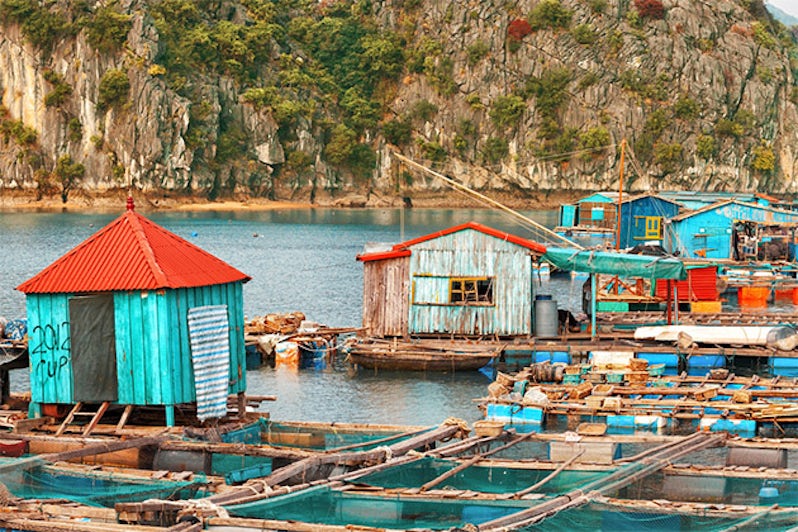
Before heading back to the Millennium, we visited a floating fishing village with its own gardens, school, and pearl oyster farm. Women from the village rowed us there in wooden boats, coming so close to the islands we could almost touch them. After a visit to the school and village gift shop, we glided past the oyster beds to a floating platform where we watched a master seed the live oysters with rounded bits of mother-of-pearl, which, in a few years, will grow into large pearls. In the gift shop we browsed jewelry made from the farm-cultured pearls.
Tip: Always inspect cultured pearls by rotating the entire strand to reveal any irregularities, including places where the coating is thin and not durable.
Hoi An Food and Fun
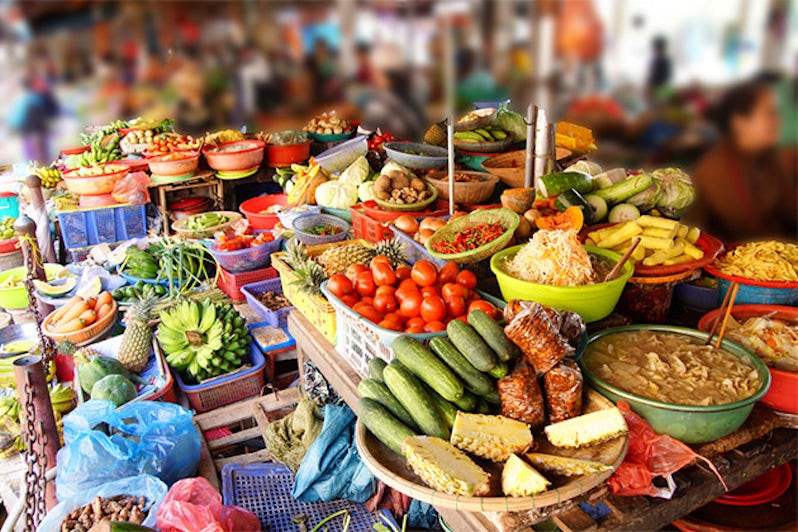
At the port of Chan May, we passed on a visit to bustling Da Nang, the country’s fifth-largest city, to explore another side of Vietnam: small but sophisticated Hoi An. This lively village is a cosmopolitan melting pot --and UNESCO World Heritage Site -- boasting brightly painted merchant houses, temples and warehouses that reflect its port-town past. Hoi An’s pedestrian-only streets are a shopper’s paradise, offering custom fashions and quality arts and crafts. There are dozens of charming restaurants, too, where visitors can pause to sample Vietnamese cuisine, beer or its famous iced coffee.
Tip: Learn more about Vietnamese cuisine in this food-loving town by taking a ship excursion to one of the village’s many cooking schools. Hoi An is also home to top-rated food tours; research them online and book in advance of your visit.
A Day in Saigon -- Err, Ho Chi Minh City
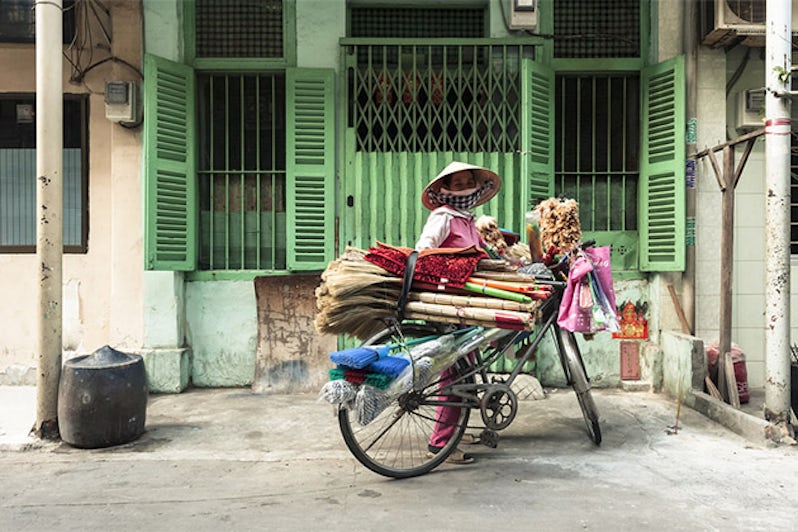
For most Americans, Saigon, now renamed Ho Chi Minh City, is synonymous with the tragic Vietnam War or as the Vietnamese call it, the American War. Our shore excursion bus to the city passed men and women wearing traditional conical hats, evoking memories of the long-ago conflict. Once in Ho Chi Minh City, we boarded cyclos -- bicycle-powered rickshaws -- and were peddled around busy city streets. Street vendors, motorbike riders and whole families waved as we wheeled by. Shopkeepers staffing the hundreds of stalls in Ben Tranh Market were equally friendly and enthusiastic as they offered us bargains we couldn’t refuse on everything from traditional silk shirts to knock-off designer leather goods.
Tip: Always carry small-denomination U.S. bills, especially plenty of ones and fives. Local vendors accept them happily, though they will give Vietnamese Dong in change.
Uncle Ho's City
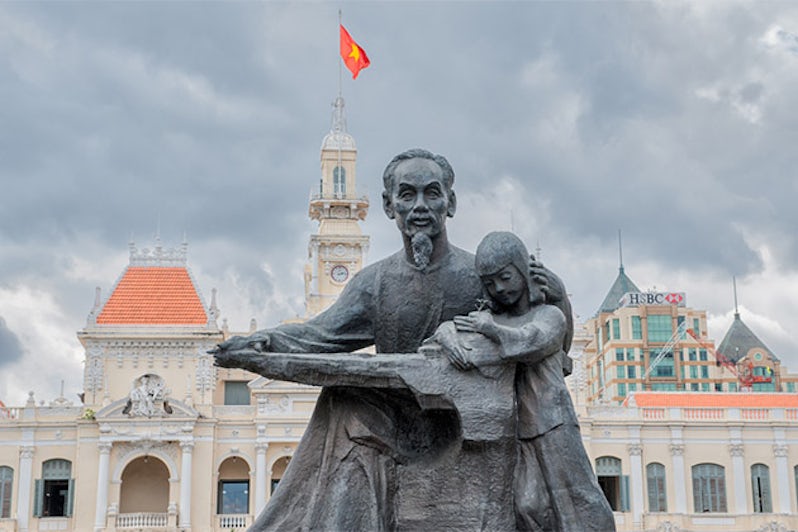
Uncle Ho, as many Vietnamese refer to Ho Chi Minh, their late revered leader, is known here as much for his love of children as his war efforts. He is depicted holding a child in a statue in the heart of the city (ironically, with the iconic French colonial post office as a backdrop). Just steps away on either side, are two more prominent reminders of French colonialism. One is the refurbished Rex Hotel with a rooftop garden bar made famous during the war as a gathering place for American military and war correspondents. Many cruise ship shuttles stop here because of its central location and modern restrooms. Also nearby is Notre Dame Cathedral, built by the French in 1877. It gained fame in October 2005 when a Virgin Mary statue is said to have shed tears there.
Tip: The Rex Hotel’s famous rooftop bar is a good spot to refresh with a cool drink while you’re waiting for the ship’s shuttle, which stops here. Expect to pay a bit more as you relax in one of the most famous bars in the world.
And It's Good Pho You

Across from Ben Thanh Market is multi-story Pho 2000, made famous when President Bill Clinton slurped the noodle soup here while working to normalize relations with Vietnam. Choose beef, chicken, seafood or vegetarian pho -- all hot, delicious and perfect matches for icy Vietnamese beer. Ho Chi Minh is a food-loving city where the fusion of Asian and French cuisines has resulted in some of the world’s best dining. Ben Thanh Market also offers a spectacular range of vendors selling spices, produce and other foods, as well as cooked dishes ranging from fried chicken, to Banh mi (wonderfully fresh baguettes stuffed with various meats, eggs, pickles and more). Ben Than is great food-market theater for visitors, but not a very safe place for visitors to have a meal.
Tip: The Ben Thanh Market’s aisles are narrow, noisy and packed with people. Be sure to protect valuables while shopping there.
Cruise and Tell
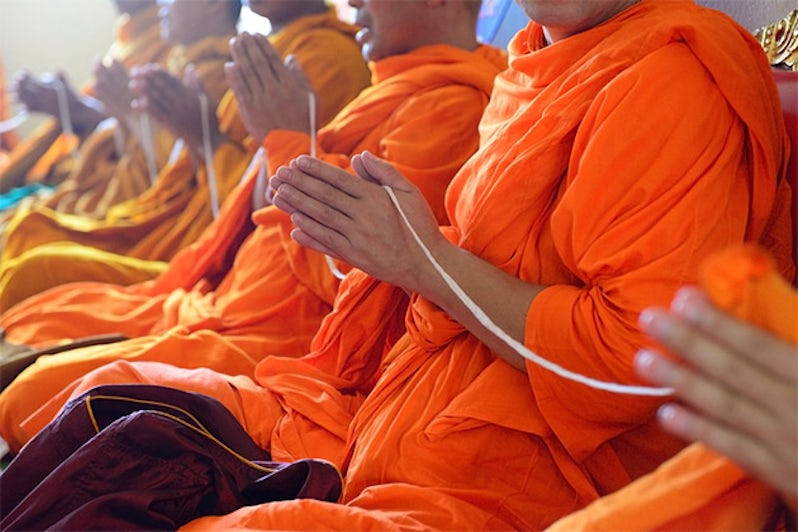
Port- and life-enrichment lectures, offered by some cruise lines, add to any cruise experience but are especially helpful when destinations are as exotic and culturally rich as Southeast Asia. To help us make the most of port stops, Sparky Hofmann, a regular lecturer on the Celebrity Asia cruise circuit, highlighted how to get around, what to see and what to buy. His talks augmented shore excursion presentations by staff that only pitched the ship’s offerings. A second series delved into Buddha and Buddhism; overviews presented with passion and wit by Marshall Stern. One day, he managed to enlist the entire crowd in meditation right before lunch. His shared insights added to our appreciation of shrines and temples throughout the region.
Tip: Passengers on ships without enrichment programs onboard can learn a lot in advance via discussion groups on sites like Cruise Critic and TripAdvisor. Cruise line websites often offer port summaries with background on each stop and its highlights. Also, most destination websites offer detailed histories and cultural information that can help plan visits.
Over-the-Top Bangkok, Thailand
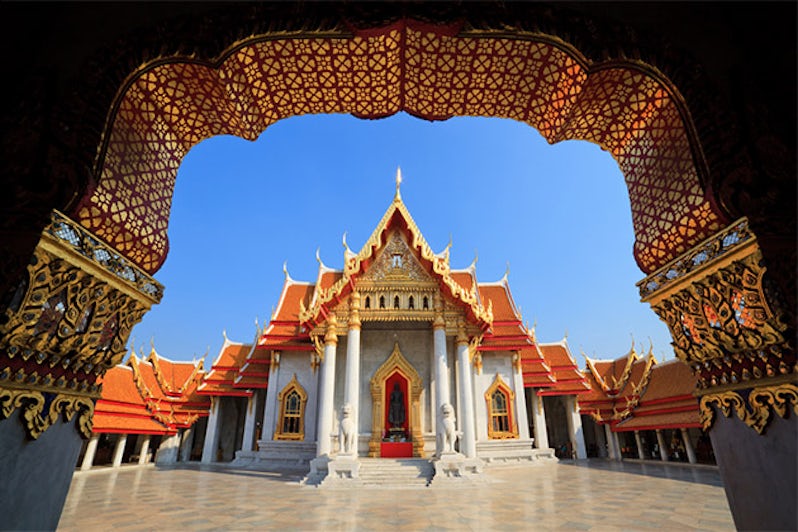
During our two-day excursion around steamy, chaotic, traffic-jammed Bangkok, we were awed by one remarkable palace, temple or Buddha after another; many embellished with gold and jewels. The walled, 200-plus-year-old Grand Palace is crammed with glittering monuments, statues and murals. Temples (or wats) here and around the city each house a signature Buddha that may be solid gold or jade, or so large it’s impossible to perceive with one glance. Even the crumbling ruins are majestic.
Tip: After touring all day, relax (and enjoy last-minute shopping) at Asiatique The Riverfront, an open-air mall where locals join visitors in evening strolls, meals and browsing for antiques and other goods. Most hotels can help arrange taxis to and from the mall, but many taxi drivers here do not speak English so be sure to get a card from your hotel with the address to help them find your way back.
The Reclining Buddha
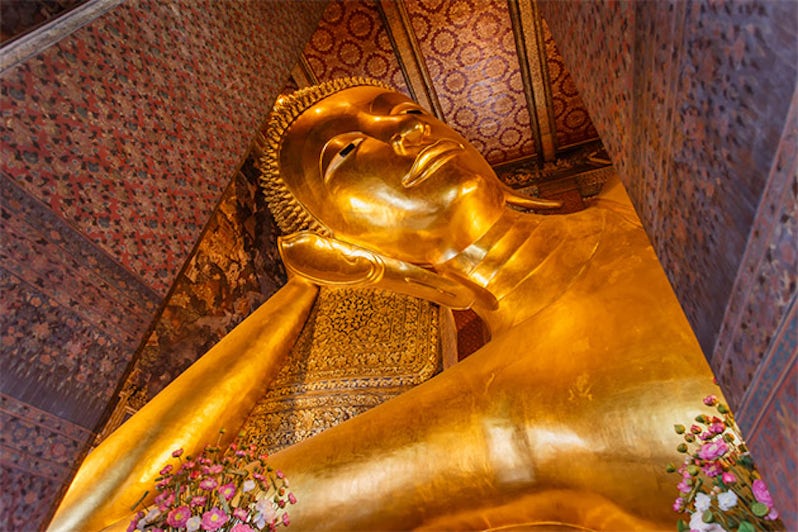
It's hard to capture the 151-foot-long Buddha in a single shot; we couldn’t fit his size 10-foot, mother-of-pearl-covered feet in one picture. The Temple of the Reclining Buddha (Wat Po), the oldest and largest temple in Bangkok, is named after a monastery in India where Buddha is believed to have lived. On the temple grounds are 91 beautiful monoliths called chedis that contain the ashes of Buddha and the royal family. Before it was a temple, the site was a center of education for traditional Thai medicine. One hall sheltered ancient illustrations of acupuncture pressure points for various ailments. By the end of the day, we could have used some needle work for our aching legs and feet.
Tip: In places of worship, dress codes apply. Research them in advance for your destination and dress appropriately. Shoes are generally removed before entering temples; wear socks or carry sanitary wipes. Photography is allowed in most places and is clearly indicated when it's not.
Sensational Singapore
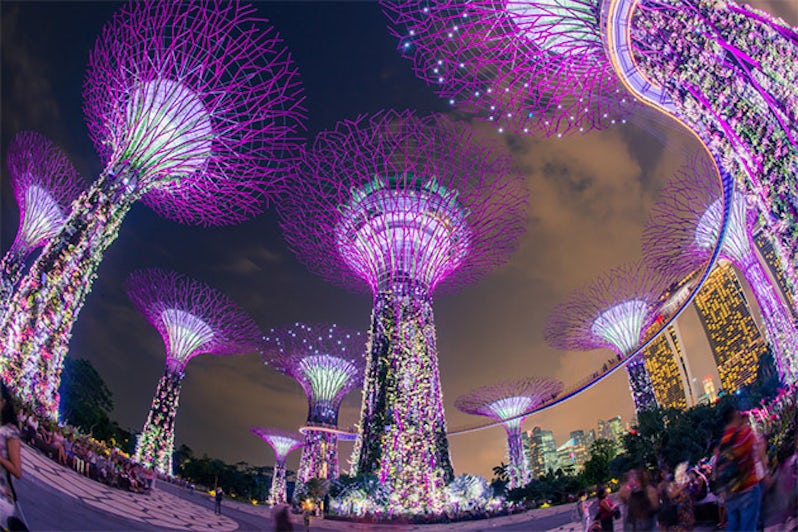
Our last port, Singapore impresses as a modern, progressive city from your first glimpse of the space-age skyline glistening in the morning sun. This densely populated urban center understands the need for parks and greenbelts; hundreds are scattered throughout the city, some even thrive on rooftops. The centerpiece is Gardens by the Bay (shown here from the top of Marina Bay Sands Hotel). Acclaimed as a world-class botanical garden, this 250-acre paradise showcases over 380,000 plants, many housed in two climate-controlled conservatories. The iconic 9-to-15-story-tall sculpted Supertrees, collect rainwater and generate solar power for the park.
Tip: Clean, metered and relatively inexpensive, taxis are the best way to get around. Most drivers speak very good English and are happy to share their knowledge of the city. Hail cabs on the street; there’s a surcharge if a hotel calls one for you.
The Singapore Sky Show

Most nights, you can take a Singapore River cruise from Clark Quay to watch the stunning laser light show that illuminates the night sky, rippling river waters and Marina Bay Sands, the city’s biggest hotel. The twice-nightly, 13-minute show is a Las Vegas-style combination of multicolored lights, flames and special effects choreographed to music. At the top of the 55-story landmark hotel is the Sands Sky Park, shaped like a humongous surfboard as long as the Eiffel tower is tall. The signature sangria we shared was a perfect cooler on a hot, windy afternoon.
Tip: Skip the hefty charge of admission to the Marina Bay Sands observation deck. Instead, opt for a visit to the sky park bar, buy a cocktail and snap pictures of the expansive view from there.
Singapore Slinging

In this city of 5 million, more than 20,000 eateries thrive, ranging from countless small cafes in ethnic neighborhoods to slick dining rooms captained by Michelin-starred chefs. Food courts in the major shopping centers lining Orchard Road offer quality and affordable choices, from hamburgers and spring rolls to pad Thai and Singapore’s national dish, chili crab (which isn’t as hot as its name suggests). Just before flying home, we satisfied the very touristy urge to sample a Singapore Sling at the historic Raffles Hotel Long Bar, where the drink was invented in 1915. They may have been pricy at $26 each, but the experience proved a worthy celebration of our Asian adventure. We gobbled up the free peanuts, tossed the shells on the floor as is the tradition, and finished our drinks -- then ordered another round.
Tip: Food court restaurants, or hawkers, are strictly managed for hygiene by the government. Plus, most are open so customers can watch food being prepared and served. Safety aside, choose one with dishes that tempt your palate or curiosity. Long lines are a good indication of locals’ favorites.